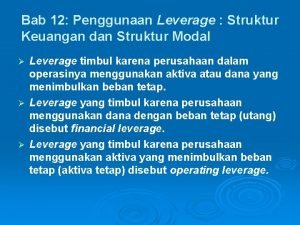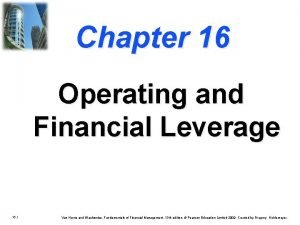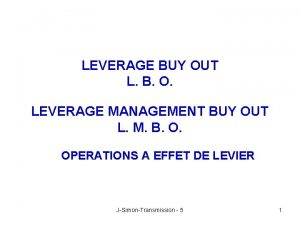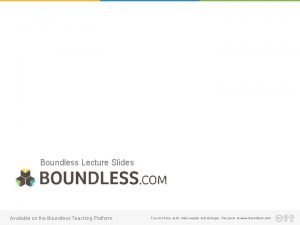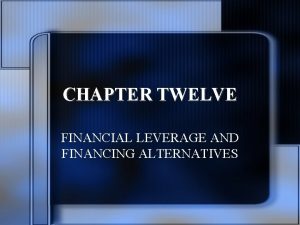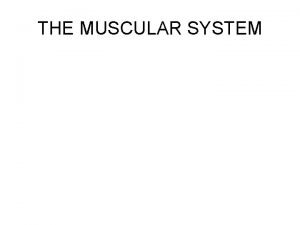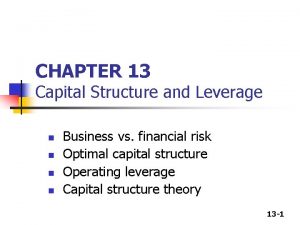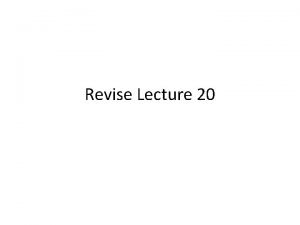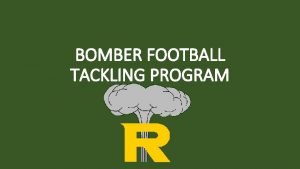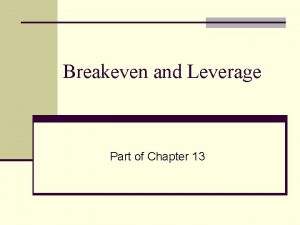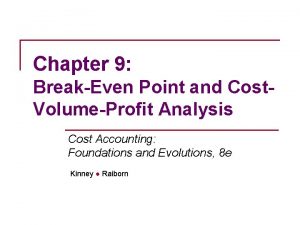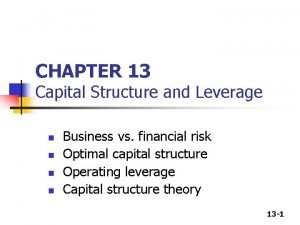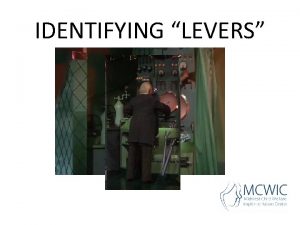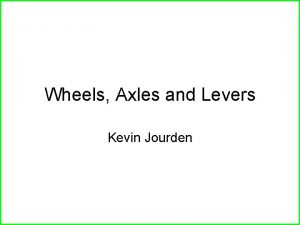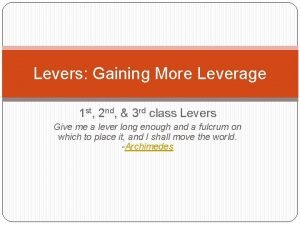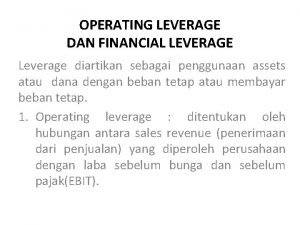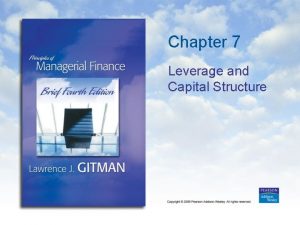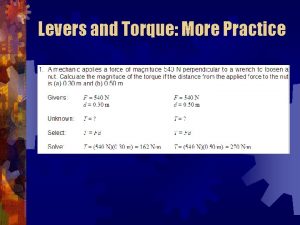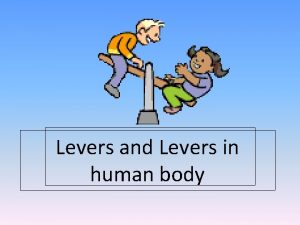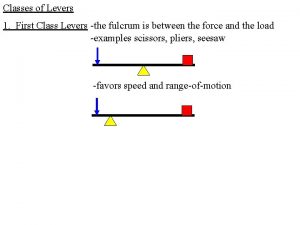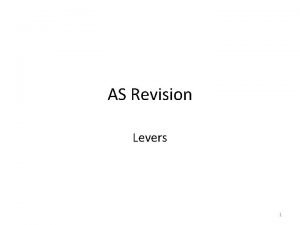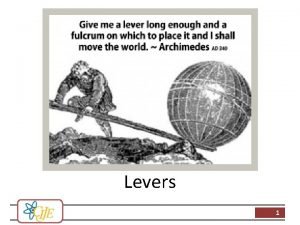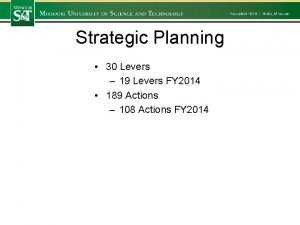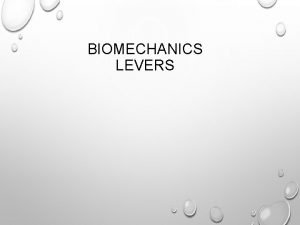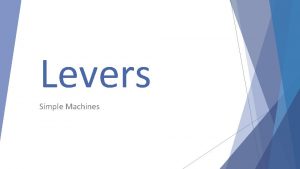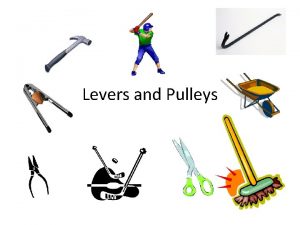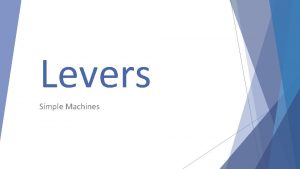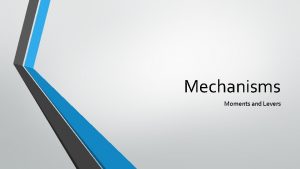Levers Gaining More Leverage 1 st 2 nd



































- Slides: 35

Levers: Gaining More Leverage 1 st, 2 nd, & 3 rd class Levers

1 st class levers review: �Look at the 1 st class lever below. �Identify the FELLA �Think of at least 3 facts related to 1 st class levers to share with the class �Discuss

1 st class levers review �F = fulcrum �E = effort �L = load �L = lever �A = arm 1 st Class Facts: v. The fulcrum is always in the middle v. Effort applied down, pulls the load up v. Levers provide a mechanical advantage making work easier v. The closer the load is to the fulcrum, the less effort it takes to lift the load v. The further the

Let’s look at more 1 st Class levers Examples in strength training � Class 1 - Seated dumbbell triceps extension � Try it! � Place a heavy book in your arm and see your body work as a 1 st class lever.

More classes of levers Look at the diagram below. What differences can you see between the different classes of levers?

Classes of Levers �Levers can be set up in three basic ways… Class 1 – fulcrum middle Class 2 – load middle Class 3 – effort middle Remember: FLE = 123

2 nd Class Levers Can you identify my FELLA?

How did you do? Class 2 - The fulcrum is at one end, the effort at the other end and the load lies between the effort and the fulcrum

Other examples of 2 nd class levers… Examples in strength training Class 2 - Standing heel lift Try a standing heel lift and see your body work as a 2 nd class lever!

Other examples of 2 nd class levers… Class 2 - Standing heel lift �Where is the load? �Would you be able to locate the load in this illustration if it were not labeled? �Why is the load sometimes difficult to identify in a class 2 lever? �RESISTANCE CAN BE CONSIDERED LOAD!!! � Remember the example of the oar from our 1 st class levers…

Let’s explore this further… �Look at the example of the nutcracker �The weight of the nut IS NOT the load. (The nutcracker is not designed to move the nut around. It is designed to crush the nut) �When you squeeze the ends of the lever, the jaws of the nutcracker push on the nut…the load is the resistance of the nut pushing back (= and opposite force anyone? )

But Miss Lamb, I’m still confused? ? ? � I can easily find the effort and fulcrum. � Why are the arrows for the load pointing away from the hot dog? [double 3 rd class lever] � Effort is applied to the tongs causing a force against the hot dog…the hot dog resists by pushing back with an opposing = force. � The load is the resistance pushed back by the hot dog.

Let’s try to identify FELLA…


�Yes, paper can push against the blades!

Fireplace bellow anyone?


How will the 2 nd class lever work? If the load and effort are found on the same side of the fulcrum, what does this mean will happen when we pull down?

Let’s try it… �Take a look at the 2 nd class lever. �What is happening? Note: Now that the scale is pulling up, you DO NOT need to add. 5 N �The load will always pull down, but the effort will always have to pull up to counteract the load.

Let’s discover more for ourselves… �Work with your teacher to set up a 2 nd class lever system. �In this case, you will be measuring load (not resistance) and the effort that it takes to lift the load �Experiment. You will have to lift up with your spring scale, what will happen to the load? �Will you have to add. 5 N to your calculations? �What happens when you move the load closer to the fulcrum? Complete the response sheet for more leverage!

Stop here for today!

Let’s review before we get started! 1. Use the “machines” graphic organizer to draw an illustration of a 1 st and 2 nd class lever. 2. Read page 10 -11 in your “Levers & Pulleys” textbook. 3. Answer the following questions: What is the mechanical advantage of a class 2 lever? What is the load in the bellows? How is the bellows like the nutcracker and garlic press? Now we are going to explore the advantage rule for 2 nd class levers.

Experiment & Discover… � Set up your 2 nd class lever. Set up your load from your assigned distance from the fulcrum. � Record your findings on the diagram in your packet. � Travel to the other desks in your row. Apply effort and record your findings on the diagram in your packet. When you are finished, return to your seat. � What do you find?

How are these classes different? � Look at the position of the fulcrum in these pictures. � What is different about the positions of the load and effort in a 2 nd and 3 rd class lever? � If the load and effort are found on the same side of the fulcrum, what does this mean will happen when we pull down?

3 rd Class Levers Class 3 - The fulcrum is at one end, the load at the other end and the effort lies between the load and the fulcrum The third class lever is the strangest. . . and the one you use the most! Some 3 rd class levers do not give any mechanical advantage So why use them? The answer lies in the fact that the load moves in the same direction as the force you apply, which

3 rd Class Levers Examples:

3 rd Class Lever Examples

They help us do work…

3 rd Class Lever Examples They help us in sports!

Many sports are played with 3 rd Class Levers!!!

3 rd Class Lever Examples Can you identify my FELLA?

Examples in strength training Class 3 - Seated biceps curl Try a seated biceps curl and see your body work as a 3 rd class lever!

More Examples of 3 rd Class Levers Double 3 rd class levers

Levers Review Can you identify which class lever I am?

Let’s reinforce… Read pages 12 -13 on levers in your “Levers & Pulleys” book Be sure you can answer the following question: *What is the mechanical advantage of a class 3 lever? Complete your graphic organizer by drawing a 3 rd class lever picture Look closer at everyday objects & determine their class
 More more more i want more more more more we praise you
More more more i want more more more more we praise you More more more i want more more more more we praise you
More more more i want more more more more we praise you Operating leverage formula using ebit
Operating leverage formula using ebit More choices more chances
More choices more chances Example of newtons first law
Example of newtons first law Human history becomes more and more a race
Human history becomes more and more a race The more you take the more you leave behind
The more you take the more you leave behind Knowing more remembering more
Knowing more remembering more The more you study the more you learn
The more you study the more you learn More love to thee o lord
More love to thee o lord Aspire not to have more but to be more
Aspire not to have more but to be more Leverage dan struktur modal
Leverage dan struktur modal Homemade leverage example
Homemade leverage example Types of leverage
Types of leverage Lift and leverage
Lift and leverage Basel 3
Basel 3 Business vs financial risk
Business vs financial risk Dette mezzanine
Dette mezzanine Homemade leverage upsc
Homemade leverage upsc Leverage-saliency theory
Leverage-saliency theory Leverage ratio wikipedia
Leverage ratio wikipedia Rumus dcl
Rumus dcl Analisis leverage
Analisis leverage Ceedar high leverage practices
Ceedar high leverage practices Muscles of the posterior leg
Muscles of the posterior leg Feedback vs coaching
Feedback vs coaching Leverage defination
Leverage defination Chapter 13 leverage and capital structure gitman ppt
Chapter 13 leverage and capital structure gitman ppt Leverage
Leverage Different types of leverage
Different types of leverage Seahawks tackling drills
Seahawks tackling drills Fast leverage matrix
Fast leverage matrix In the context of operating leverage break even analysis
In the context of operating leverage break even analysis Break even units formula
Break even units formula Modigliani and miller theory
Modigliani and miller theory Leveraging brand associations
Leveraging brand associations











